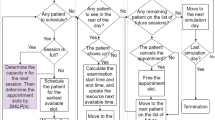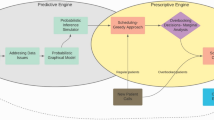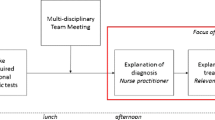Abstract
Clinical overbooking is intended to reduce the negative impact of patient no-shows on clinic operations and performance. In this paper, we study the clinical scheduling problem with overbooking for heterogeneous patients, i.e. patients who have different no-show probabilities. We consider the objective of maximizing expected profit, which includes revenue from patients and costs associated with patient waiting times and physician overtime. We show that the objective function with homogeneous patients, i.e. patients with the same no-show probability, is multimodular. We also show that this property does not hold when patients are heterogeneous. We identify properties of an optimal schedule with heterogeneous patients and propose a local search algorithm to find local optimal schedules. Then, we extend our results to sequential scheduling and propose two sequential scheduling procedures. Finally, we perform a set of numerical experiments and provide managerial insights for health care practitioners.
Similar content being viewed by others
References
Altman, E., Gaujal, B., & Hordijk, A. (2000). Multimodularity, convexity and optimization properties. Mathematics of Operations Research, 25, 324–347.
Bodenheimer, T., & Grumbach, K. (2002). Understanding health policy: a clinical approach. Lange Medical Books (3rd ed.). New York: McGraw-Hill.
Cayirli, T., & Veral, E. (2003). Outpatient scheduling in health care: a review of literature. Production and Operations Management, 12, 519–549.
Centers for Medicare and Office of the Actuary Medicaid Services. (2005). National health care expenditures projections: 2005–2015.
Garuda, S., Javalgi, R., & Talluri, V. (1998). Tackling no-show behavior: a market-driven approach. Health Marketing Quarterly, 15, 25–44.
Hajek, B. (1985). Extremal splitting of point processes. Mathematics of Operations Research, 10, 543–556.
Kaandorp, G., & Koole, G. (2007). Optimal outpatient appointment scheduling. Health Care Management Science, 10, 217–229.
Kim, S., & Giachetti, R. (2006). A stochastic mathematical appointment overbooking model for healthcare providers to improve profits. IEEE Transactions on Systems, Man, and Cybernetics. Part A: Systems and Humans, 36, 1211–1219.
Koole, G., & van der Sluis, E. (2003). Optimal shift scheduling with a global service level constraint. IIE Transactions, 35, 1049–1055.
Laganga, L., & Lawrence, S. (2007a). Clinic overbooking to improve patient access and provider productivity. Decision Sciences, 38, 251–276.
Laganga, L., & Lawrence, S. An appointment overbooking model to improve client access and provider productivity. Technical report, University of Colorado at Boulder (2007b).
Liu, L., & Liu, S. (1998). Dynamic and static job allocation for multi-server systems. IIE Transactions, 30, 845–854.
Murray, M., & Berwick, D. (2003). Advanced access: reducing waiting and delays in primary care. The Journal of the American Medical Association, 289, 1035–1040.
Murray, M., & Tantau, C. (2000). Same-day appointments: exploding the access paradigm. Family Practice Management, 7, 45–50.
Muthuraman, K., & Lawley, M. (2008). A stochastic overbooking model for outpatient clinical scheduling with no-shows. IIE Transactions, 40, 820–837.
Puterman, M. (1994). Markov decision processes—discrete stochastic dynamic programming. New York: Wiley.
Randolph, G., Murray, M., Swanson, J., & Margolis, P. (2004). Behind schedule: improving access to care for children one practice at a time. Pediatrics, 113, 230–237.
Robinson, L., & Chen, R. (2008). The effects of patient no-shows on appointment scheduling policies. Technical report, Cornell University and University of California Davis.
Rust, C., Clark, N., Clark, W., Jones, D., & Wilcox, W. (1995). Patient appointment failures in pediatric resident continuity clinics. Archives of Pediatrics and Adolescent Medicine, 149, 693–695.
Shonick, W., & Klein, B. (1977). An approach to reducing the adverse effects of broken appointments in primary care systems: Development of a decision rule based on estimated conditional probabilities. Medical Care, 15, 419–429.
Author information
Authors and Affiliations
Corresponding author
Additional information
The work was supported by NSF Grant CMMI 0729463.
Rights and permissions
About this article
Cite this article
Zeng, B., Turkcan, A., Lin, J. et al. Clinic scheduling models with overbooking for patients with heterogeneous no-show probabilities. Ann Oper Res 178, 121–144 (2010). https://doi.org/10.1007/s10479-009-0569-5
Published:
Issue Date:
DOI: https://doi.org/10.1007/s10479-009-0569-5




